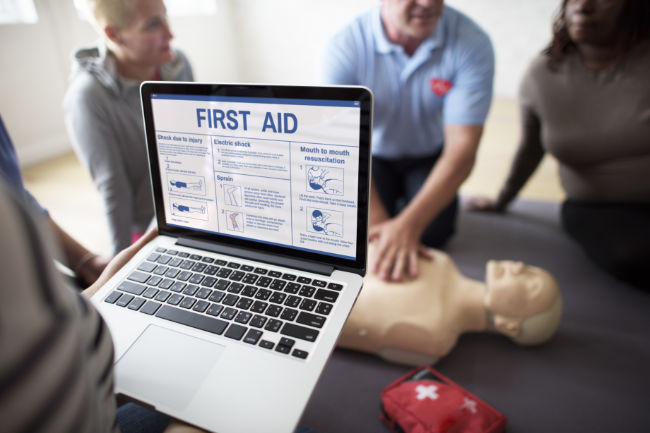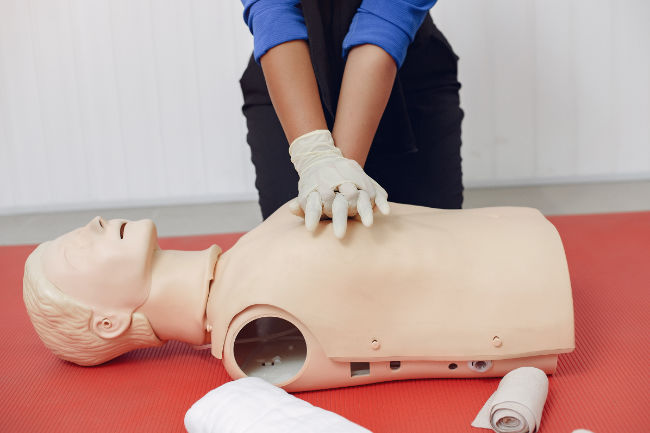Table of Contents
- The Early History of CPR Training
- CPR in the Digital Age
- Online vs. In-Person vs. Blended CPR Training
- Common Misconceptions About Online CPR Training
- The Future of Online CPR Training
Cardiopulmonary resuscitation (CPR) has been around for centuries, so the history of CPR is long and complex. As technology and medicine have advanced — and continue to do so — so do CPR best practices. Today, online CPR training and certification are a convenient, accessible way to do what used to have to be done in person.
By bringing CPR into the digital age, the medical world has made it possible for people of all ages, social classes, and lifestyles to learn a skill that helps save lives. Now, almost anyone can get just as effective and in-depth an understanding of CPR as they would have in person — but from the comfort of their own home and at a time that works for them.
Keep reading to learn about the contemporary history of CPR and how it has evolved into the CPR of the digital age that we know today.
The Early History of CPR Training
CPR is an emergency procedure used to help restore breathing and circulation to someone whose heart has stopped beating. It involves chest compressions and, if necessary, rescue breaths to circulate oxygen-rich blood to the brain and other vital organs.
CPR can be performed by a medical professional or by a bystander, as long as they are properly trained in how to do it. But while the use of CPR can be traced back as far as ancient Egypt, CPR training didn’t become mainstream until around the 1960s.
In fact, in 1972, a man named Leonard Cobb taught the first CPR course to over 100,000 people over two years. In the 1980s, CPR was taught over the phone — the first time people could learn the skill from home — and then, in the early 2000s, online CPR courses were created to help healthcare professionals complete their certifications from home.
CPR Before the 1700s
Before the formalization of CPR, historical records offer glimpses of primitive resuscitation techniques dating back to ancient civilizations. Ancient societies, such as the Egyptians and Greeks, used basic methods like shaking and blowing air into the mouth to revive the unconscious.
These methods, rooted in spiritual beliefs, laid the groundwork for later developments in resuscitation. While often ineffective by modern standards, these early attempts at resuscitation demonstrated humanity’s innate instinct to aid those in distress.
These early methods underscored the importance of intervention in life-threatening situations.
CPR in the 1700s
The 18th century had significant strides in medical understanding and the formalization of resuscitative techniques. In 1740, the Paris Academy of Sciences introduced the concept of mouth-to-mouth resuscitation, attributing its effectiveness to air inflow into the lungs.
Mouth-to-mouth resuscitation laid the foundation
for modern CPR.
Medical professionals across Europe began experimenting with various methods, contributing to a growing body of research. The 1700s marked a significant shift towards a more systematic approach to resuscitation, with physicians increasingly advocating for standardized techniques based on scientific principles.
Despite these advancements, resuscitative efforts remained limited until the 1800s.
CPR in the 1800s
The 19th century marked a period of refinement and innovation in resuscitative practices. In 1859, Dr. Friedrich Maass introduced the first recorded chest compressions, advocating for a combination of artificial respiration and chest compression.
His work set the stage for further advancements in CPR methodology. Medical professionals explored novel techniques throughout the century, paving the way for widespread CPR adoption.
The 1800s witnessed a growing interest in the physiology of respiration and circulation, prompting researchers to dive deeper into the mechanisms of successful resuscitation.
CPR in the 1900s
The 20th century experienced the formalization and widespread adoption of CPR as an essential life-saving technique. Dr. Peter Safar and Dr. James Elam popularized mouth-to-mouth resuscitation in 1960, refining its methodology.
Subsequent advancements like Automated External Defibrillators (AEDs) further revolutionized CPR. Training became standardized and accessible, empowering individuals to intervene effectively in emergencies.
The latter half of the century was about integrating CPR training into schools and workplace safety programs, increasing public awareness and participation in life-saving efforts.
As technology advances and medical knowledge expands, the legacy of CPR is a cornerstone of modern emergency medicine.
Learn more about when CPR was invented and explore where the industry is headed.
CPR in the Digital Age
The internet has revolutionized how we learn, and organizations across industries are recognizing the value of offering online learning. CPR is no exception. Online learning has made CPR training and certification more accessible and cost-effective, thereby allowing for a deeper and more widespread understanding of the technique.
Online CPR training has a number of benefits, including:
- It’s more convenient than traditional in-person courses
- It’s cost-effective
- It offers a variety of payment options
- It can be taken at any time and from anywhere
- It provides the same level of instruction as in-person courses
Online CPR courses have also improved the quality of CPR training. Many courses include interactive elements, such as simulated scenarios, that help to reinforce the knowledge of the history of CPR and the necessary skills gained through the course. This helps ensure that individuals receiving the training are better prepared to take action in an emergency.
Virtual reality (VR) simulations have revolutionized CPR training by immersing learners in realistic scenarios where they can practice life-saving techniques in a simulated environment. VR technology enhances skill retention and preparedness by providing hands-on experience in a safe and controlled setting.
The digital age has marked a huge step in the history of CPR with the development of more advanced CPR techniques. For example, CPR training now includes the use of AEDs and other medical devices that can be used to help save lives.
Mobile applications specializing in CPR can also play a crucial role in training. They offer on-the-go access to instructional videos, step-by-step guides, and interactive quizzes. These apps are valuable resources for reinforcing CPR knowledge and skills empowering individuals to respond confidently in emergencies.
Social media and online communities have facilitated knowledge sharing and collaboration among CPR practitioners and instructors. Platforms like YouTube and Facebook provide forums for sharing instructional videos, discussing best practices, and disseminating updates on CPR guidelines and protocols.
The Pandemic & CPR Training
The COVID-19 pandemic has impacted CPR training in various ways, prompting adaptations to ensure safety while maintaining the effectiveness of instruction.
Social distancing guidelines have led to the implementation of virtual CPR training sessions. These online courses allow participants to learn CPR skills remotely, reducing the risk of virus transmission in group settings.
Because of this, many organizations have started offering free or discounted online CPR courses to help people stay safe during the pandemic. Online and blended courses have become the norm for people who want to complete CPR training from anywhere and at their own pace.
There’s been an emphasis on incorporating proper infection control measures into CPR training protocols. This includes using personal protective equipment (PPE), such as face masks and gloves, during hands-on practice sessions.
CPR training organizations have updated their curriculum to include guidelines specific to performing CPR during the COVID-19 pandemic. Modifications to the recommended compression-to-ventilation ratio and techniques have been made to minimize the risk of virus transmission while providing assistance.
While COVID-19 has posed challenges to traditional CPR training methods, it has also sparked adaptation within the field. With adaptation comes innovation! No matter what happens, CPR training will be continuously updated to ensure individuals continue to receive essential lifesaving skills safely and effectively.
Online vs. In-Person vs. Blended CPR Training
There are three main types of online CPR training options — fully online, fully in person, and blended. Fully online courses are designed to be completed entirely online, while fully in-person classes are designed to be completed in person.
Blended courses, on the other hand, involve a combination of online and in-person components. These courses usually require students to attend a hands-on virtual skills evaluation session, as well as complete online coursework. The type of course you choose will depend on your needs and preferences.
It’s worth noting that some online courses offer a variety of payment options, so you can choose the one that works best for you. At ProTrainings, for example, we offer a Pass > Pay > Print option for some of our courses, where training and testing are free of charge and you only pay if you choose to get certified.
Common Misconceptions About Online CPR Training
Since digital learning has become increasingly prevalent, online CPR training must offer a convenient and accessible way for individuals to acquire life-saving skills. However, misconceptions surrounding online CPR training abound, often leading to skepticism about its effectiveness and legitimacy.
- Online training is less effective than in-person training. One common misconception is that online CPR training is less effective than in-person instruction. This is simply not true — online courses offer the same level of instruction and prepare students for real-life emergencies and in-person classes.
- Online CPR training lacks hands-on experience. Nowadays, online courses can fully replicate the hands-on experience of in-person training, with many programs offering virtual simulations and interactive resources. Additionally, blended programs like the ProTrainings Blended program combine the convenience and efficiency of online training with the addition of hands-on skills development.
- Accrediting bodies do not recognize an online CPR course. Reputable online CPR training programs adhere to in-person course guidelines and standards. Certifications obtained through these programs are widely accepted by employers and regulatory agencies. For example, ProTrainings is accepted by 99% of employers, including the U.S. Coast Guard and CAPCE.
- Online CPR training is only suitable for healthcare professionals. While online CPR training is commonly associated with healthcare professionals, it is ideal for many individuals, including teachers, childcare providers, fitness instructors, tradespeople, and more!
- Online training courses make it too easy to cheat or skim through. Some assume online CPR training is too easy to cheat or skim through, leading to subpar learning outcomes. However, reputable online training platforms implement rigorous assessments, quizzes, and hands-on practical evaluations.
As technology advances, online CPR training will play an increasingly vital role. It will equip individuals from diverse backgrounds and professions with the extensive knowledge and skills to save lives.
The Future of Online CPR Training & Certification
The future of online CPR training and certification looks bright. As more organizations recognize the value of offering online courses, the demand for these courses will continue to grow. Thankfully, the emergence of online training and certification has made it easier for organizations to offer CPR courses to their employees.
This has led to more workplaces offering CPR training, which can help ensure the safety of employees in an emergency.
Online CPR training courses will continue to evolve with interactive learning platforms that engage participants through multimedia elements, virtual reality simulations, and real-life scenarios.
These platforms will incorporate real-time feedback and assessment mechanisms to evaluate learners’ performance. Through wearable sensors and monitoring devices, participants can receive immediate feedback on the quality of their compressions and ventilations.
In our modern world, we need algorithms, and CPR is no exception! The future of online CPR training will leverage adaptive learning algorithms to personalize educational experiences based on learners’ proficiency and learning styles. These algorithms analyze learners’ progress and adapt course content and pacing accordingly.
Additionally, we could see the integration of online CPR training programs and telemedicine platforms. By enabling remote coaching and support from certified instructors, learners can receive real-time guidance and assistance in CPR.
Integrating CPR training and telemedicine expands access to high-quality CPR training and support, particularly in underserved or remote communities.
As technology continues to evolve, so does the landscape of lifesaving education, offering innovative solutions that empower individuals with the knowledge and skills to respond confidently in cardiac emergencies.
Follow us on Facebook to learn more about the history of CPR and our group and remote-staff CPR certification programs.


